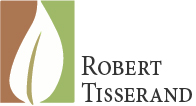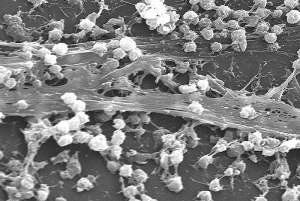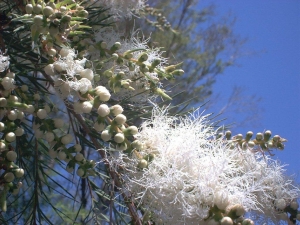One of the outstanding properties of many essential oils, including tea tree (Melaleuca alternifolia), is that they can be effective even against bacterial biofilms.
A biofilm is a layered matrix, consisting mainly of polysaccharide and protein, that bacteria or fungi create on a surface as a secure habitat. In this form they are more difficult to kill, because the biofilm structure affords protection from the environment. Plaque on teeth is an example of a biofilm and the success of ‘essential oil’ mouthwashes such as Listerine compared to others is partly due to their ability to break down and inhibit plaque formation (Oyanagi et al 2012). (Listerine contains four essential oil constituents: thymol, menthol, 1,8-cineole and methyl salicylate. It was originally developed and used as a surgical antiseptic.)
In a biofilm, the outer layer consists of more or less dormant cells that are also especially resistant. Medical implants, such as heart valves, catheters, stents etc, are becoming more common. They are subject to colonization by bacterial biofilms, and if this occurs the result can be fatal, as antibiotics have great difficulty penetrating the outer layer of resistant bacteria (Hoiby et al 2010). Consequently, implant-related fatalities are on the rise.
Carvacrol and cinnamaldehyde (major constituents of oregano oil and cinnamon bark oil respectively) inhibited biofilm formation on a polymer coating. It is proposed that medical devices coated with such compounds would be much less susceptible to bacterial colonization. Cinnamaldehyde significantly reduced Pseudomonas aeruginosa biofilm at 1%, and most bacteria were inhibited by either compound at 0.1% (Zodrow et al 2012). P. aeruginosa is one of the most difficult bacteria to kill. It forms mucosal biofilms in the lungs in cystic fibrosis, and it can be a problem in wound healing.
Biofilm may be found on contact lenses, chronic wounds and ulcers, vaginal mucous membrane, in fact on any surface where there is moisture and nutrients. It is constantly forming on our skin, in addition to the usual mix of dirt, sebum, sweat and cosmetics. Biofilms are also found on surfaces outside the body. Because of a combination of grease-cutting and antibiofilm properties, pine oil and orange oil are common ingredients in household disinfectants. More on biofilms here.
In vitro testing often shows antibiotics to be more effective than essential oils. Conversely, some essential oils are more effective at killing bacteria in biofilm, because they can penetrate it more effectively, and because they are less susceptible to resistant mechanisms. Essential oils that have shown good antibiofilm action in in vitro testing include:
- Cinnamon bark: Staphylococcus epidermis biofilm (Nuryastuti et al 2009)
- Oregano: S. aureus and S. epidermis biofilm (Nostro et al 2007)
- Thyme: Listeria monocytogenes biofilm on stainless steel and polystyrene (Desai et al 2012)
- Rosemary: Candida albicans and C. tropicalis biofilm (Chifiriuc et al 2012)
- Tea tree: S. aureus, MRSA and C.albicans biofilm (Kwiecinski et al 2009, Park et al 2007, Sudjana et al 2012)
Some of these essential oils are now being considered for use in food preservation, another situation where biofilm formation is a challenge.
Staphylococcus aureus is a ubiquitous bacterium, notably found on the skin. In vitro research shows that tea tree oil dose-dependently eradicates S. aureus biofilm (Kwiecinski et al 2009) and that it is effective against MRSA and MSSA biofilm (Brady et al 2006). A 50% concentration of tea tree oil was as effective as vancomycin in vitro in eradicating MRSA biofilm on typanostomy tubes (Park et al 2007). S. aureus biofilm, in an infected cochlear implant, was found to be resistant to all conventional antimicrobials, but 5% tea tree oil completely eradicated it in one hour (Brady et al 2010). Tea tree oil has shown good effect in eradicating MRSA on the skin, used at 5% in a body wash, in addition to either 4% in an ointment (Caelli et al 2000) or 10% in a cream (Dryden et al 2004).
Candida albicans forms biofilms that cause disease and are difficult to treat with conventional antifungal agents. At 0.031% in vitro, tea tree oil significantly reduced biofilm formation for all of 10 C. albicans isolates tested (Sudjana et al 2012). Further in vitro work suggests that tea tree oil may be effective in oral hygiene products for the prevention and control of oral candidosis in cancer patients (Bagg et al 2006, Ramage et al 2012). In 25 AIDS patients with oral candidosis who had not responded to fluconazole treatment, 7 were cured and 8 improved after four weeks using oral solutions containing tea tree oil (Vazquez et al 2002).
These studies suggest promising uses for essential oils, notably tea tree, in the prevention and eradication of biofilm-related medical problems that may be resistant to conventional treatment, as well as in surface cleaning, hand hygiene and skin cleansing products.
References
Bagg J, Jackson MS, Sweeney MP et al 2006 Susceptibility to Melaleuca alternifolia (tea tree) oil of yeasts isolated from the mouths of patients with advanced cancer. Oral Oncology 42:487-492
Brady A, Loughlin R, Gilpin D et al 2006 In vitro activity of tea-tree oil against clinical skin isolates of meticillin-resistant and -sensitive Staphylococcus aureus and coagulase-negative staphylococci growing planktonically and as biofilms. Journal of Medical Microbiology 55:1375-1380
http://jmm.sgmjournals.org/content/55/10/1375.full.pdf+html
Brady AJ, Farnan TB, Toner JG et al 2010 Treatment of a cochlear implant biofilm infection: a potential role for alternative antimicrobial agents. Journal of Laryngology, Rhinology & Otology 124:729-738
Caelli M, Porteous J, Carson CF et al 2000 Tea tree oil as an alternative topical decolonization agent for methicillin-resistant Staphylococcus aureus. Journal of Hospital Infection 46:236-237
Chifiriuc C, Grumezescu V, Grumezescu AM et al 2012 Hybrid magnetite nanoparticles/Rosmarinus officinalis essential oil nanobiosystem with antibiofilm activity. Nanoscale Research Letters 7:209
http://www.ncbi.nlm.nih.gov/pmc/articles/PMC3368737/
Desai MA, Soni KA, Nannapaneni R et al 2012 Reduction of Listeria monocytogenes biofilms on stainless steel and polystyrene surfaces by essential oils. Journal of Food Protection 75:1332-1337
Dryden MS, Dailly S, Crouch M 2004 A randomized, controlled trial of tea tree topical preparations versus a standard topical regimen for the clearance of MRSA colonization. Journal of Hospital Infection 56:283-286
Hoiby N, Bjarnsholt T, Givskov M et al 2010 Antibiotic resistance of bacterial biofilms. International Journal of Antimicrobial Agents 35:322-332
Kwiecinski J, Eick S, Wojcik K 2009 Effects of tea tree (Melaleuca alternifolia) oil on Staphylococcus aureus in biofilms and stationary growth phase. International Journal of Antimicrobial Agents 33:343-347
Nostro A, Sudano Roccaro A et al 2007 Effects of oregano, carvacrol and thymol on Staphylococcus aureus and Staphylococcus epidermidis biofilms. Journal of Medical Microbiology 56:519-523
http://jmm.sgmjournals.org/content/56/4/519.long
Nuryastuti T, van der Mei HC et al 2009 Effect of cinnamon oil on icaA expression and biofilm formation by Staphylococcus epidermidis. Applied & Environmental Microbiology 75:6850-6855
http://www.ncbi.nlm.nih.gov/pmc/articles/PMC2772433/
Oyanagi T, Tagami J, Matin K et al 2012 Potentials of mouthwashes in disinfecting cariogenic bacteria and biofilms leading to inhibition of caries. The Open Dentistry Journal 6:23-30
http://www.ncbi.nlm.nih.gov/pmc/articles/PMC3269010/
Park H, Jang CH, Cho YB et al 2007Antibacterial effect of tea-tree oil on methicillin-resistant Staphylococcus aureus biofilm formation of the tympanostomy tube: an in vitro study. In Vivo 21:1027-1030
http://iv.iiarjournals.org/content/21/6/1027.long
Ramage G, Milligan S, Lappin DF et al 2012 Antifungal, cytotoxic, and immunomodulatory properties of tea tree oil and its derivative components: potential role in management of oral candidosis in cancer patients. Frontiers in Microbiology 3:220
Sudjana AN, Carson CF, Carson KC et al 2012 Candida albicans adhesion to human epithelial cells and polystyrene and formation of biofilm is reduced by sub-inhibitory Melaleuca alternifolia (tea tree) essential oil. Medical Mycology 50:863-870
Vazquez JA, Zawawi AA 2002 Efficacy of alcohol-based and alcohol-free melaleuca oral solution for the treatment of fluconazole-refractory oropharyngeal candidiasis in patients with AIDS. HIV Clinical Trials 3:379-385
Zodrow KR, Schiffman JD, Elimelech M 2012 Biodegradable polymer (PLGA) coatings featuring cinnamaldehyde and carvacrol mitigate biofilm formation. Langmuir 28:13993-13999





This has been a very informative read. Thank you Robert.
Thank you, that was really interesting. I love tea tree oil.
Interestingly, I recently heard that a friend is treating toe fungus with warm Listerine foot soaks. Now it makes sense why this might even work! Thanks for the informative article.
This is a great in-depth look at tea tree. Thanks for putting it all together.
Great article Robert – thanks for doing the research and writing all of this down in a easily understandable format. We need to get this type of information out to the general public. Very much appreciate all that you do.
Thanks for the thorough explanation. What type of oil treatment might help eradicate Pseudomonas aeruginosa that is discovered in one’s lower intestines? (fecal test positive)
Enterically coated peppermint oil capsules help to re-balance intestinal flora (Colpermin, Mintec, or Heather’s Tummy Tamers) as do probiotics. Otherwise, essential oils taken orally won’t do much as very little of the oil will reach the colon.
Thanks much–makes a lot of sense. This is someone who is immuno-compromised and who will likely also pursue colonic therapy. If oils were placed in the enema, would they be effective? She’s trying to avoid antibiotics.
Essential oil in colonic is difficult, because the oil needs to be 100% dispersed in the water, because most of the water does not remain in the body, and because it would not be effective unless carried out almost daily for some time. Suppositories might be more effective in all of these respects.
Excellent, thank you. I will pass this on (no pun intended).
Hi there, I read this about lemongrass, Cymbopogon citratus Stapf: “Lemongrass possessed the strongest antiviral activity of the essential oils used in the study. At a concentration of 0.1% lemongrass showed the stronger antiviral activity than tea tree. The study concluded that lemongrass essential oil may be the most effective essential oil against HSV-1 infection. The topical use of essential oils, especially lemongrass, for the treatment of recurrent HSV-1 infections may be useful for recurrent ocular and dermal infection with HSV-1. (HSV-1 =Herpes simplex virus type-1)” (Minami, et al. 2003). What are your thoughts and experience?
Hi Ann, lemongrass is one of the most useful antifungal essential oils, and it has very good antibacterial and antiviral properties too. Here are some papers about lemongrass and antibiofilm properties: http://www.ncbi.nlm.nih.gov/pubmed/?term=lemongrass+AND+biolfilm. However, lemongrass should not be used at more than 0.7% on the skin, to avoid irritation or allergy.